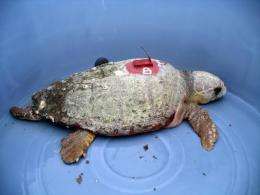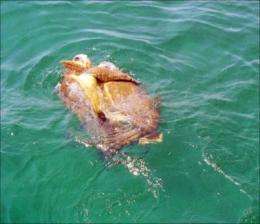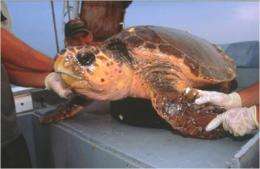Satellite tracking of sea turtles reveals potential threat posed by manmade chemicals

The first research to actively analyze adult male sea turtles (Caretta caretta) using satellite tracking to link geography with pollutants has revealed the potential risks posed to this threatened species by manmade chemicals. The research, published today in Environmental Toxicology and Chemistry, examines the different levels of chemicals in the blood of both migratory and residential turtles.
"The risks posed by persistent organic pollutants (POPs) remain largely a mystery for threatened loggerhead sea turtles," said lead author Jared Ragland from the College of Charleston, South Carolina. "A clear understanding of these risks is critical for wildlife managers trying to maintain both the health of reproductively active individuals and a sustainable population overall."
Twenty-nine turtles were captured near Port Canaveral, Florida and fitted with satellite transmitters as part of a National Marine Fisheries Service-funded project. Blood was analyzed for traces of organochlorine pesticides (OCPs), polychlorinated biphenyls (PCBs), polybrominated diphenyl ethers (PBDEs) and toxaphenes, chemicals documented to have carcinogenic and neurodevelopmental effects.

Of the 29 turtles tracked, 19 were analyzed for POPs for which they were separated into two groups and tracked for 60 days. Ten transient turtles travelled north along the U.S. Atlantic coast, eventually arriving in shelf water between New Jersey and South Carolina, while nine turtles remained resident at Cape Canaveral.
The tracking data revealed significantly different movement patterns between transient and resident adult males. Individuals migrating north after breeding season were found to have elevated blood plasma concentrations of POPs, putting them at higher risk to toxic effects compared to the turtles that remained in Florida.
The findings support the idea that foraging location can influence exposure to, and patterns of, POPs in highly mobile species such as sea turtles. Migrating turtles face cumulative poisoning as contaminants infiltrate the food chain through prey species, such as crabs.

"Our research is the first to examine POPs in the rarely studied adult male sea turtle and to couple contaminant measurements with satellite tracking," concluded Ragland. "Although the turtle has been listed as threatened for more than 30 years, it is only now that we can begin to examine the effects of manmade chemicals on these animals in the wild."
Provided by Wiley

















